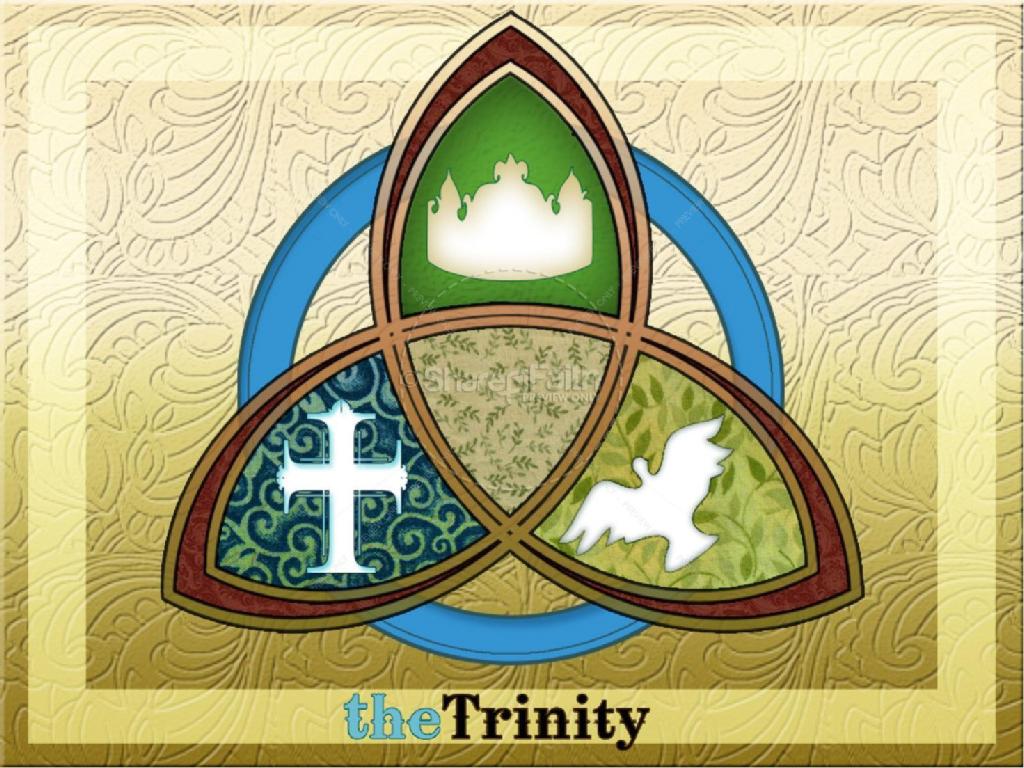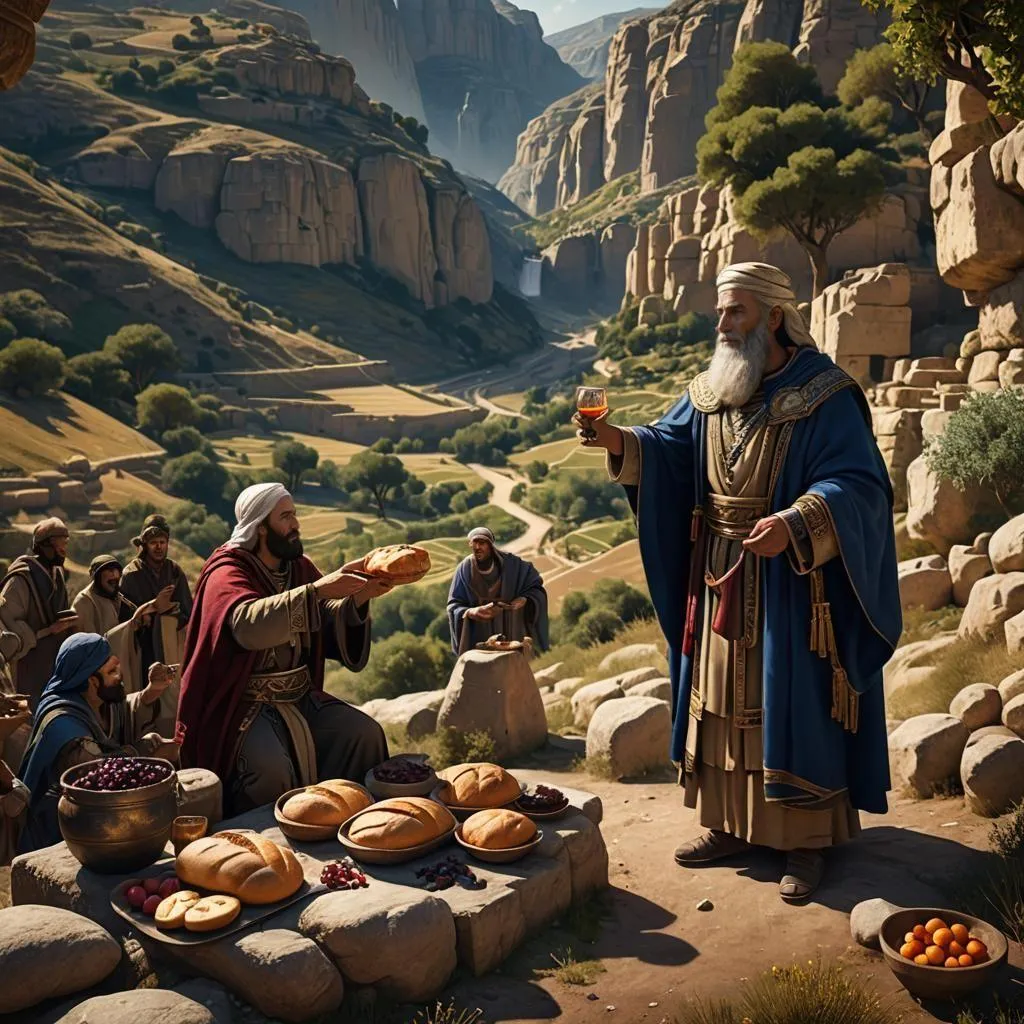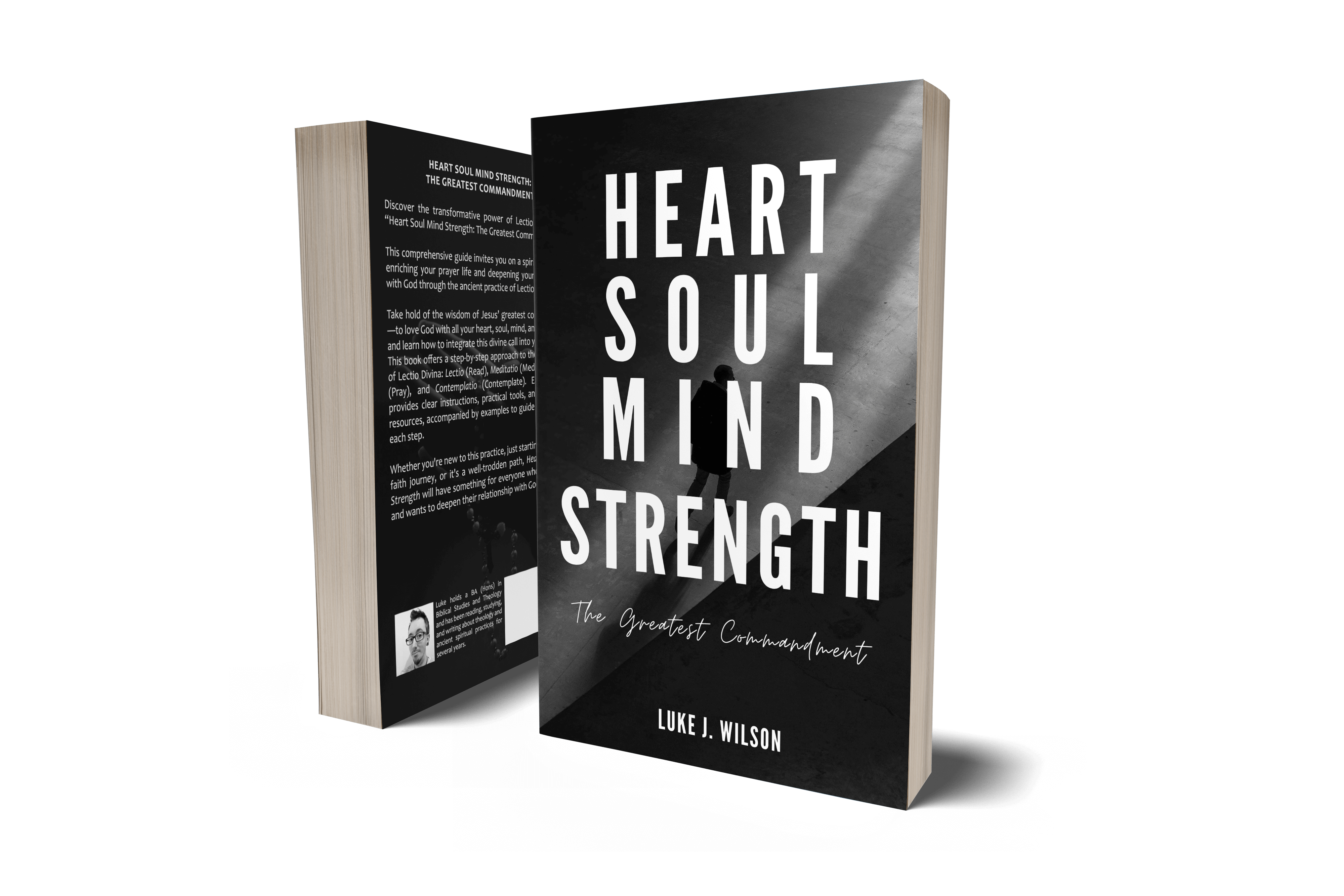The Coming Kingdom of the Son of Man
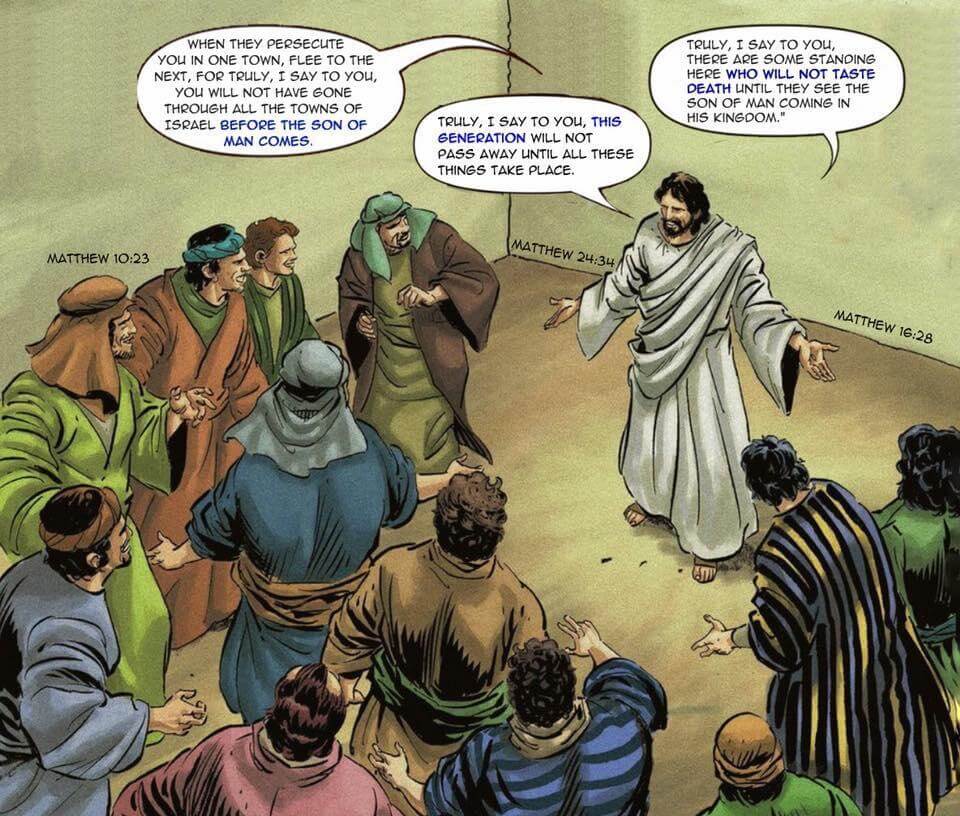
The importance of context of what's being said, and to whom, in Scripture.
I came across this image the other day (in the header above; see larger here) that links together three parts of Matthew’s Gospel to highlight the connection which many often miss, or read as separate events. I like the image because it shows that when Jesus spoke these things, he would have been saying them directly to the disciples and others who were listening to his teaching, and not in some cryptic, ambiguous dictation to a prophetic scribe, devoid of all context and meaning to those around him at the time.
Update Feb 2017: I am adding some additional information to this to display some of the counter arguments/alternative interpretations used by dispensationalists, sometimes also called “Futurists” (those who believe these passages refer to a distant future event centred around the “Second Coming” of Jesus, and is typically the most popular and recent interpretive framework taught in churches today) to try and give a more well rounded view and a defense of the non-dispensational interpretation.
So let's break it down and look at each quote in a bit more detail to see how these all connect together coherently.
Matt 10:23
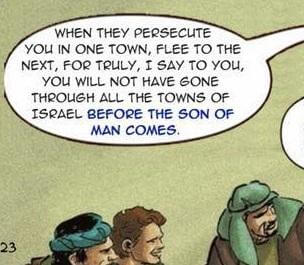
Matthew 10 is Jesus telling his disciples about their mission and the persecutions it would entail. He explains to them all the things that would happen to them – "they will hand you over to councils and flog you in their synagogues; and you will be dragged before governors and kings because of me" (Matt 10:17), which we can see fulfilled in Acts (cf. Acts 8:1; Acts 11:19; Acts 13:50; Acts 14:22; Acts 20:23).
Jesus rounds this short discussion off by telling them to flee from one town to the next and that they "will not have gone through all the towns of Israel before the Son of Man comes." (Matt 10:23), which gives us a time statement and some parameters about the coming of the Son of Man.
On the face of it, this sounds like any other eschatological statement by Jesus in regards to his “coming” at the end of the age, which he mentions a few times using this same or similar terminology (see: Matt 24:27; 25:31; Mark 8:38; Luke 9:26; 18:8). But the Futurist interpretation would say that this isn’t what Jesus refers to at all, but rather is a convoluted way of him saying “you won’t have travelled far until I catch up with you later” – ie. until Jesus (the Son of Man) comes [back to the apostles]. That conclusion is quite a stretch of the imagination and, like the other dispensationalist interpretation which says that this refers to some far future event, it completely rips it from its direct and immediate context: a message to the apostles.
But, as many commentaries point out, the Futurist interpretation was not the common view until recent times, nor the historical position of the Church for millennia. As the Benson commentary (amongst others) puts it:
...until the Son of man shall come — To destroy their capital city, temple, and nation. The destruction of Jerusalem by Titus is often called the coming of the Son of man. See Matthew 24:27; Matthew 24:37; Matthew 24:39; Matthew 24:44; Luke 18:5.
"The son of man comes" or the "coming of the son of man" is a phrase only used in one particular way all the way throughout the Gospels: to mean the judgement of God on a nation. This is seen in many places in the Old Testament, often called the Day of the Lord. The same is true here, Jesus is once again teaching about the impending doom of Jerusalem as punishment. Hence the urgency towards his disciples to flee towns that won't listen and go to where they do accept the Gospel.
Matthew 24:34
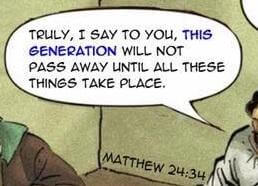
Matthew 24 is a similar conversation, but with some more details.
Whilst walking by the temple, the disciples point out the magnificence of the building, and Jesus responds by saying "Truly I tell you, not one stone will be left here upon another; all will be thrown down." (v.2)
So obviously, the disciples ask the poignant question: "Tell us, when will this be, and what will be the sign of your coming and of the end of the age?" (v.3) – notice here that they also link the tearing down of the temple with the “end of the age”.
To which Jesus begins his long monologue on what is going to happen, the destruction of the temple and of Jerusalem, and the signs leading up to this event for his followers to watch out for. Again, he tells them of the impending persecutions that will befall them because of this ("Then they will hand you over to be tortured and will put you to death").
The parallel account in Luke 21 words this persecution almost word-for-word with Matt 10:23 –
"But before all this [the signs and destruction] occurs, they will arrest you and persecute you; they will hand you over to synagogues and prisons, and you will be brought before kings and governors because of my name."
Luke 21:12
Now, Jesus goes further with his explanation and shows how this ties in with Daniel's prophecy (Daniel 9:20-27), which his Jewish audience would have understood. Matthew's Gospel was written to a Jewish community, and so keeps this language:
"So when you see the desolating sacrilege standing in the holy place, as was spoken of by the prophet Daniel (let the reader understand), then those in Judea must flee to the mountains..." (Matt 24:15)
Whereas Luke's Gospel was written by a Gentile, to Gentiles, and thus clarifies certain things so that non-Jews will understand, such as what that the “desolating sacrilege” is:
"When you see Jerusalem surrounded by armies, then know that its desolation has come near. Then those in Judea must flee to the mountains..."
Luke 21:20
Jesus then rounds up with more apocalyptic imagery from Daniel's prophecy which speaks of the Son of Man coming on clouds – a direct quote of Dan 7:14;
"Then the sign of the Son of Man will appear in heaven, and then all the tribes of the earth will mourn, and they will see ‘the Son of Man coming on the clouds of heaven’ with power and great glory. "
Matt 24:30
If we also look at when Jesus was before the Council being accused in his trial, the High Priest asks Jesus directly if he is the Messiah, to which he says "I am" and then quotes Dan 7:14 to prove his point and tells them what they will soon see (Matt 26:57-68).
Towards the end of this chapter, Jesus uses a fig tree to emphasise the need to be watchful for the signs he already explained, and then concludes by saying "this generation will not pass away until all these things have taken place" (Matt 24:34), once again giving a pretty solid time frame for when those listening should expect to see these things come to pass.
But despite all of this, the Futurist will argue that when Jesus said “this generation”, he actually meant “that future generation who live to see these signs” which completely strips this of any context and meaning to those people he spoke to. There are some Dispensationalist teachers who say that the Greek word for “generation” should be translated as “race”, changing the meaning to say “this race shall not pass away” despite all other instances of the word “generation” meaning just that: a generation. You can read a more detailed counter-argument to this “race” claim, and all the implications of it, here: americanvision.org/1689/norman-l-geisler-generation/.
Jesus talks about judgement coming on "this generation" more than just here in Matt 24 where the context and grammar is the same (Matt 12:41-45; 23:36; Mark 8:36; Luke 11:50 to name a few). This interpretation is just a weak argument which willfully ignores other parts of Scripture or reinterprets words, to force a doctrine (Futurism/Dispensationalism) into the text rather than let Scripture dictate doctrine.
Matthew 16:28
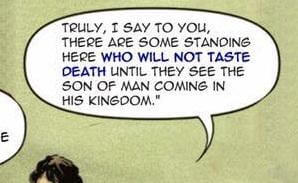
The final quote in the image comes from Matt 16:28 where Jesus rounds off his dialogue foretelling his death and resurrection, and subsequent coming Kingdom. Taken in the context of verse 27, this again harkens back to the prophecy in Daniel 7 about the Son of Man coming into power with his eternal kingdom and the position of judgement he will have over the nations: "For the Son of Man is to come with his angels in the glory of his Father, and then he will repay everyone for what has been done" (v.27).
After saying this, Jesus emphasises the imminence of this event by saying that "there are some standing here who will not taste death before they see the Son of Man coming in his kingdom".
The Futurist argument says that coming kingdom is referring to the transfiguration, and that the suicide of Judas fulfils Jesus’ words about some of those with him not “tasting death” before they see the kingdom come. On the face of it, this sounds like a fair counterpoint, until you consider the situation and see that there are a couple of reasons why this doesn’t make sense.
The first reason being the most striking, is that after Jesus spoke these words, the transfiguration happened only six days later and we know this because Scripture gives us the time in Matt 17:1 (and Mark 9:2). That makes Jesus’ statement about some people not dying before seeing the kingdom a little bit over-dramatic if it was only less than a week away! The second point being that Jesus only took Peter, James and John with him, so Judas wasn’t even there to witness the transfiguration before his death — not to mention that he wouldn’t have even known about it since Jesus swore the three disciples to silence until after the resurrection (Matt 17:9).
Still, there are some Bible teachers who would use a "slice and dice" Futurist hermeneutic. What I mean by this is that sometimes certain scholars will "slice" up a passage of Scripture, in arbitrary places like mid-sentence, to make it fit a particular theological interpretation (the same thing is often done with parts of Matt 24). For example, some would say verses 27 and 28 are not dealing with the same subject, and that verse 27 is about the end of time but suddenly verse 28 is about the transfiguration!
But we can see from examples like John 21:20-23 that Jesus' followers believed that some of them would not die before his coming, as we can see Peter trying to quiz Jesus on whether one of them would die or not before then (thus starting a rumour among the disciples that John wouldn't die!).
This outlook and expectation can be seen throughout the New Testament, with so many references to these things happening "soon" or in a "very little while" (Heb 10:37), or it being the "last hour" (1 John 2:18) and what "must soon take place" (Rev 1:1), plus many more similar phrases.
To Summarise
Each of these quotes are different conversations and various times of teaching by Jesus to his disciples, and whoever else was around at the time, which all talk about the same event: the coming of the Kingdom of the Son of Man, and the signs and things to look out for in the lead up to said event. Namely, the destruction of Jerusalem being the obvious and most catastrophic event which his followers would notice, which God was bringing as a judgement against the nation of Israel like he did in former times, and the establishment of the Church in power!
This is just a brief look at this topic and the few passages surrounding it, but if it’s sparked your interest, then you can read more about this by following through my seven part study on the “Second Coming of Jesus”.
Further Reading:
- Benson Commentary: http://biblehub.com/commentaries/benson/matthew/10.htm
-
Various Commentaries: http://biblehub.com/commentaries/matthew/10-23.htm
-
Jackson, Wayne. "What Is the Meaning of Matthew 10:23?" ChristianCourier.com. Access date: January 29, 2017. https://www.christiancourier.com/articles/668-what-is-the-meaning-of-matthew-10-23
-
Norman Geisler: “This Generation” or “This Race” Will Not Pass Away? http://americanvision.org/1689/norman-l-geisler-generation/
- List of 101 time indicators throughout the NT: http://www.preteristarchive.com/Hyper/2002_green_time-indicators.html
- http://www.theopedia.com/dispensationalism
- http://www.theopedia.com/preterism
- https://thesacredfaith.co.uk/home/perma/1401098149/article/the-coming-of-jesus-intro.html
Leave a comment Like Back to Top Seen 1.7K times Liked 2 times
Enjoying this content?
Support my work by becoming a patron on Patreon!
By joining, you help fund the time, research, and effort that goes into creating this content — and you’ll also get access to exclusive perks and updates.
Even a small amount per month makes a real difference. Thank you for your support!
Subscribe to Updates
If you enjoyed this, why not subscribe to free email updates and join over 864 subscribers today!
My new book is out now! Order today wherever you get books
Recent Posts
Luke J. Wilson | 19th August 2025 | Fact-Checking
A poetic post has been circulating widely on Facebook, suggesting that our anatomy mirrors various aspects of Scripture. On the surface it sounds inspiring, but when we take time to weigh its claims, two main problems emerge. The viral post circulating on Facebook [Source] First, some of its imagery unintentionally undermines the pre-existence of Christ, as if Jesus only “held the earth together” for the 33 years of His earthly life. Second, it risks reducing the resurrection to something like biological regeneration, as if Jesus simply restarted after three days, instead of being raised in the miraculous power of God. Alongside these theological dangers, many of the scientific claims are overstated or symbolic rather than factual. Let’s go through them one by one. 1. “Jesus died at 33. The human spine has 33 vertebrae. The same structure that holds us up is the same number of years He held this Earth.” The human spine does generally have 33 vertebrae, but that number includes fused bones (the sacrum and coccyx), and not everyone has the same count. Some people have 32 or 34. More importantly, the Bible never says Jesus was exactly 33 when He died — Luke tells us He began His ministry at “about thirty” (Luke 3:23), and we know His public ministry lasted a few years, but His precise age at death is a tradition, not a biblical statement. See my other recent article examining the age of Jesus here. Theologically, the phrase “the same number of years He held this Earth” is problematic. Jesus did not hold the world together only for 33 years. The eternal Word was with God in the beginning (John 1:1–3), and “in Him all things hold together” (Colossians 1:17). Hebrews says He “sustains all things by His powerful word” (Hebrews 1:3). He has always upheld creation, before His incarnation, during His earthly ministry, and after His resurrection. To imply otherwise is to risk undermining the pre-existence of Christ. 2. “We have 12 ribs on each side. 12 disciples. 12 tribes of Israel. God built His design into our bones.” Most people do have 12 pairs of ribs, though some are born with an extra rib, or fewer. The number 12 is certainly biblical: the 12 tribes of Israel (Genesis 49), the 12 apostles (Matthew 10:1–4), and the 12 gates and foundations of the New Jerusalem (Revelation 21). But there’s no biblical connection between rib count and these symbolic twelves. This is a case of poetic association, not design woven into our bones. The only real mention of ribs in Scripture is when Eve is created from one of Adam’s ribs in Genesis 2:21–22, which has often led to the teaching in some churches that men have one less rib than women (contradicting this new claim)! 3. “The vagus nerve runs from your brain to your heart and gut. It calms storms inside the body. It looks just like a cross.” The vagus nerve is real and remarkable. It regulates heart rate, digestion, and helps calm stress, and doctors are even using vagus nerve stimulation as therapy for epilepsy, depression, and inflammation showing it really does “calm storms” in the body. But it does not look like a cross anatomically. The language about “calming storms” may echo the way Jesus calmed the storm on the Sea of Galilee (Mark 4:39), but here again the poetic flourish stretches science (and Scripture) beyond what’s accurate. 4. “Jesus rose on the third day. Science tells us that when you fast for 3 days, your body starts regenerating. Old cells die. New ones are born. Healing begins. Your body literally resurrects itself.” There’s a serious theological problem here. To equate Jesus’ resurrection with a biological “regeneration” after fasting is to misrepresent what actually happened. Fasting can indeed trigger cell renewal and immune repair, but it cannot bring the dead back to life. It’s still a natural process that happens...
Luke J. Wilson | 08th July 2025 | Islam
“We all worship the same God”. Table of Contents 1) Where YHWH and Allah Appear Similar 2) Where Allah’s Character Contradicts YHWH’s Goodness 3) Where Their Revelations Directly Contradict Each Other 4) YHWH’s Love for the Nations vs. Allah’s Commands to Subjugate 5) Can God Be Seen? What the Bible and Qur’an Say 6) Salvation by Grace vs. Salvation by Works Conclusion: Same God? Or Different Revelations? You’ve heard it from politicians, celebrities, and even some pastors. It’s become something of a modern mantra, trying to shoehorn acceptance of other beliefs and blend all religions into one, especially the Abrahamic ones. But what if the Bible and Qur’an tell different stories? Let’s see what their own words reveal so you can judge for yourself. This Tweet recently caused a stir on social media 1) Where YHWH and Allah Appear Similar Many point out that Jews, Christians, and Muslims share a belief in one eternal Creator God. That’s true — up to a point. Both the Bible and Qur’an describe God as powerful, all-knowing, merciful, and more. Here’s a list comparing some of the common shared attributes between YHWH and Allah, with direct citations from both Scriptures: 26 Shared Attributes of YHWH and Allah According to the Bible (NRSV) and the Qur’an Eternal YHWH: “From everlasting to everlasting you are God.” — Psalm 90:2 Allah: “He is the First and the Last…” — Surah 57:3 Creator YHWH: “In the beginning God created the heavens and the earth.” — Genesis 1:1 Allah: “The Originator of the heavens and the earth…” — Surah 2:117 Omnipotent (All-Powerful) YHWH: “Nothing is too hard for you.” — Jeremiah 32:17 Allah: “Allah is over all things competent.” — Surah 2:20 Omniscient (All-Knowing) YHWH: “Even before a word is on my tongue, O LORD, you know it.” — Psalm 139:4 Allah: “He knows what is on the land and in the sea…” — Surah 6:59 Omnipresent (Present Everywhere) YHWH: “Where can I go from your Spirit?” — Psalm 139:7–10 Allah: “He is with you wherever you are.” — Surah 57:4 Holy YHWH: “Holy, holy, holy is the LORD of hosts.” — Isaiah 6:3 Allah: “The Holy One (Al-Quddus).” — Surah 59:23 Just YHWH: “A God of faithfulness and without injustice.” — Deuteronomy 32:4 Allah: “Is not Allah the most just of judges?” — Surah 95:8 Merciful YHWH: “The LORD, merciful and gracious…” — Exodus 34:6 Allah: “The Most Gracious, the Most Merciful.” — Surah 1:1 Compassionate YHWH: “As a father has compassion on his children…” — Psalm 103:13 Allah: “He is the Forgiving, the Affectionate.” — Surah 85:14 Faithful YHWH: “Great is your faithfulness.” — Lamentations 3:22–23 Allah: “Indeed, the promise of Allah is truth.” — Surah 30:60 Unchanging YHWH: “For I the LORD do not change.” — Malachi 3:6 Allah: “None can change His words.” — Surah 6:115 Sovereign YHWH: “The LORD has established his throne in the heavens…” — Psalm 103:19 Allah: “Blessed is He in whose hand is dominion…” — Surah 67:1 Loving YHWH: “God is love.” — 1 John 4:8 Allah: “Indeed, my Lord is Merciful and Affectionate (Al-Wadud).” — Surah 11:90 Forgiving YHWH: “I will not remember your sins.” — Isaiah 43:25 Allah: “Allah forgives all sins…” — Surah 39:53 Wrathful toward evil YHWH: “The LORD is a jealous and avenging God…” — Nahum 1:2 Allah: “For them is a severe punishment.” — Surah 3:4 One/Unique YHWH: “The LORD is one.” — Deuteronomy 6:4 Allah: “Say: He is Allah, One.” — Surah 112:1 Jealous of worship YHWH: “I the LORD your God am a jealous God.” �...
Luke J. Wilson | 05th June 2025 | Blogging
As we commemorated the 500th anniversary of the Protestant Reformation this year, the familiar image of Martin Luther striding up to the church door in Wittenberg — hammer in hand and fire in his eyes — has once again taken centre stage. It’s a compelling picture, etched into the imagination of many. But as is often the case with historical legends, closer scrutiny tells a far more nuanced and thought-provoking story. The Myth of the Door: Was the Hammer Ever Raised? Cambridge Reformation scholar Richard Rex is one among several historians who have challenged the romanticised narrative. “Strangely,” he observes, “there’s almost no solid evidence that Luther actually went and nailed them to the church door that day, and ample reasons to doubt that he did.” Indeed, the first image of Luther hammering up his 95 Theses doesn’t appear until 1697 — over 180 years after the fact. Eric Metaxas, in his recent biography of Luther, echoes Rex’s scepticism. The earliest confirmed action we can confidently attribute to Luther on 31 October 1517 is not an act of public defiance, but the posting of two private letters to bishops. The famous hammer-blow may never have sounded at all. Conflicting Accounts Philip Melanchthon, Luther’s successor and first biographer, adds another layer of complexity. He claimed Luther “publicly affixed” the Theses to the door of All Saints’ Church, but Melanchthon wasn’t even in Wittenberg at the time. Moreover, Luther himself never mentioned posting the Theses publicly, even when recalling the events years later. Instead, he consistently spoke of writing to the bishops, hoping the matter could be addressed internally. At the time, it was common practice for a university disputation to be announced by posting theses on church doors using printed placards. But no Wittenberg-printed copies of the 95 Theses survive. And while university statutes did require notices to be posted on all church doors in the city, Melanchthon refers only to the Castle Church. It’s plausible Luther may have posted the Theses later, perhaps in mid-November — but even that remains uncertain. What we do know is that the Theses were quickly circulated among Wittenberg’s academic elite and, from there, spread throughout the Holy Roman Empire at a remarkable pace. The Real Spark: Ink, Not Iron If there was a true catalyst for the Reformation, it wasn’t a hammer but a printing press. Luther’s Latin theses were swiftly reproduced as pamphlets in Basel, Leipzig, and Nuremberg. Hundreds of copies were printed before the year’s end, and a German translation soon followed, though it may never have been formally published. Within two weeks, Luther’s arguments were being discussed across Germany. The machinery of mass communication — still in its relative infancy — played a pivotal role in what became a theological, political, and social upheaval. The Letters of a Conscientious Pastor Far from the bold revolutionary of popular imagination, Luther appears in 1517 as a pastor deeply troubled by the abuse of indulgences, writing with respectful concern to those in authority. In his letter to Archbishop Albrecht of Mainz, he humbly addresses the archbishop as “Most Illustrious Prince,” and refers to himself as “the dregs of humanity.” “I, the dregs of humanity, have so much boldness that I have dared to think of a letter to the height of your Sublimity,” he writes — hardly the voice of a man trying to pick a fight. From Whisper to Roar Luther’s initial appeal through formal channels was, predictably, ignored. He was advised not to make trouble. But as opposition mounted and corruption remained unchecked, the once quiet reformer grew louder. His theological convictions deepened, and his public persona evolved. The lion did eventually roar — but not on October 31. A Catholic Reformer, Not a Protestant Founder It’s vital to remem...
Luke J. Wilson | 20th May 2025 | Islam
You are not alone. Around the world, many Muslims — people who already believe in one God, pray, and seek to live righteously — are drawn to know more about Jesus (ʿĪsā in Arabic). Some have heard He is more than a prophet. Some have sensed His presence in a dream or vision. And some simply long to know God more deeply, personally, and truly. So what does it mean to become a Christian? And how can you take that step? This guide is for you. 1. What Christians Believe About God and Jesus ➤ One God, Eternal and Good Christians believe in one God — the same Creator known to Abraham, Moses, and the prophets. But we also believe God is more personal and relational than many realise. In His love, He has revealed Himself as Father, Son (Jesus), and Holy Spirit — not three gods, but one God in three persons. ➤ Jesus Is More Than a Prophet Muslims honour Jesus as a great prophet, born of the virgin Mary. Christians also affirm this — but go further. The Bible teaches that Jesus is the Word of God (Kalimat Allāh), who became flesh to live among us. He performed miracles, healed the sick, raised the dead — and lived without sin.Jesus came not just to teach but to save — to bring us back to God by bearing our sins and rising again in victory over death. 2. Why Do We Need Saving? ➤ The Problem: Sin All people — no matter their religion — struggle with sin. We lie, get angry, feel jealous, act selfishly, or fail to love God fully. The Bible says: “All have sinned and fall short of the glory of God.” (Romans 3:23) Sin separates us from God. And no matter how many good deeds we do, we can never make ourselves perfect or holy before Him. ➤ The Solution: Jesus Because God loves us, He did not leave us in our sin. He sent Jesus, His eternal Word, to live as one of us. Jesus died willingly, offering His life as a sacrifice for our sins, then rose again on the third day. “But God proves his love for us in that while we still were sinners Christ died for us.” (Romans 5:8) 3. How Do I Become a Christian? Becoming a Christian is not about joining a Western religion. It’s about entering a relationship with God through faith in Jesus Christ. Here is what the Bible says: ✝️ 1. Believe in Jesus Believe that Jesus is the Son of God, that He died for your sins, and that He rose again. “If you confess with your lips that Jesus is Lord and believe in your heart that God raised him from the dead, you will be saved.” (Romans 10:9) 💔 2. Repent of Your Sins Turn away from sin and ask God to forgive you. This is called repentance. It means being truly sorry and choosing a new way. “Repent therefore, and turn to God so that your sins may be wiped out.” (Acts 3:19) 💧 3. Be Baptised Jesus commands His followers to be baptised in water as a sign of their new life. Baptism represents washing away your old life and rising into a new one with Jesus. “Repent and be baptised every one of you in the name of Jesus Christ so that your sins may be forgiven.” (Acts 2:38) 🕊️ 4. Receive the Holy Spirit When you believe in Jesus, God gives you the Holy Spirit to live within you, guiding you, comforting you, and helping you follow His will. “You received the Spirit of adoption, by whom we cry, ‘Abba! Father!’” (Romans 8:15) 🧎 5. Begin a New Life As a Christian, you are born again — spiritually renewed. You begin to grow in faith, love, and holiness. You read the Bible, pray, fast, and gather with other believers. Your life is no longer your own; you now live for God. 4. What Does a Christian Life Look Like? Jesus said: “If anyone wants to become my followers, let them deny themselves and take up their cross and follow me.” (Matthew 16:24) This means: Loving God with all your heart Loving your neighbour — even your enemies Forgiving others ...








